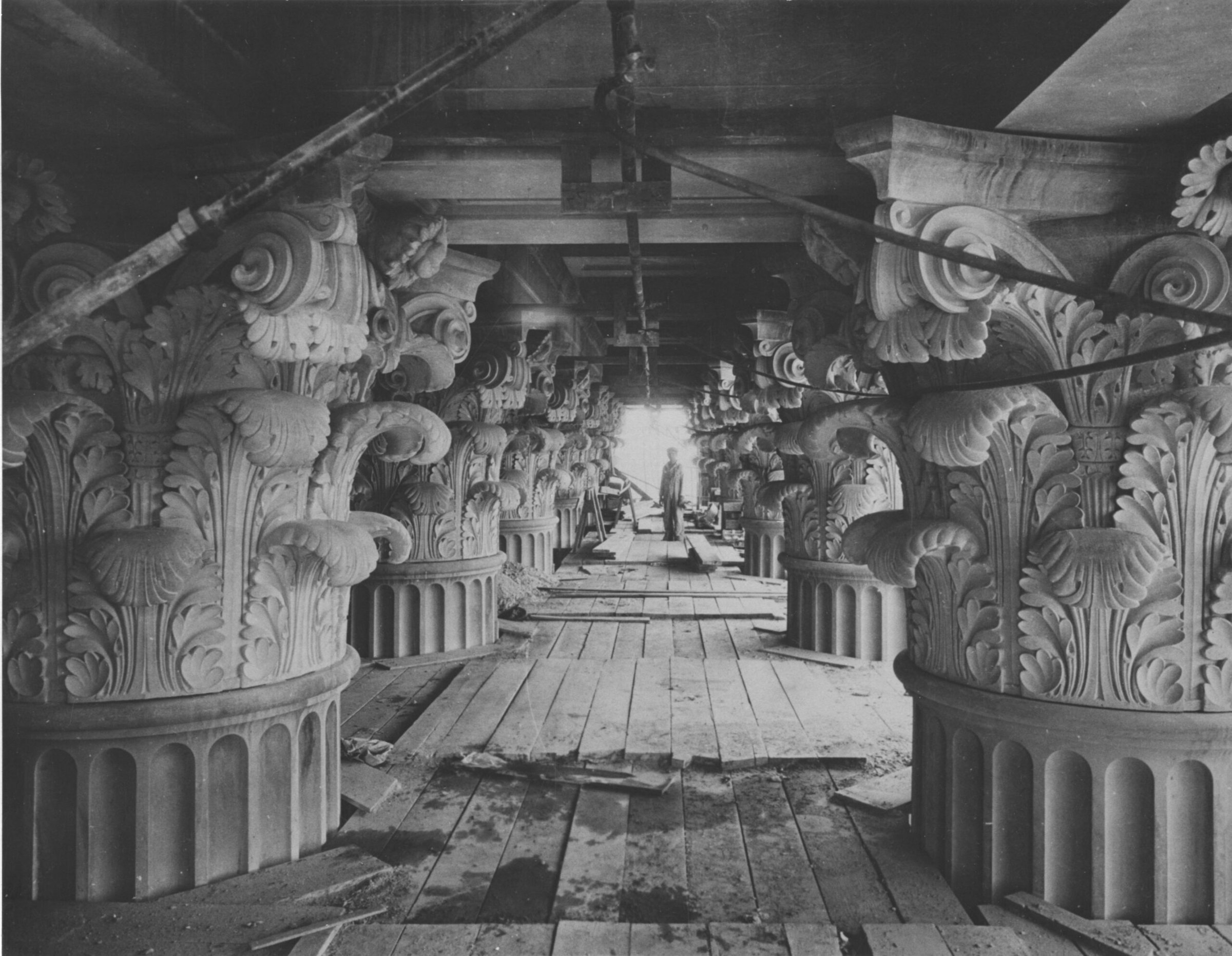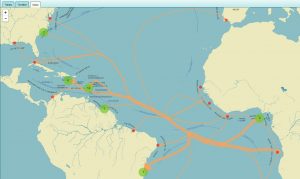Most of us know of the civil rights movement in the post-World War II period of U.S. history. Less well known is the fact that a civil rights movement in Atlanta beginning in 1880 was the precursor. The strategies adopted by black activists during a period of resistance from 1880 to 1910 became a foundation for the later emergence of Atlanta as the cradle of the civil rights movement.
Direct Action Strikes and Boycotts
The 1881 Washerwomen’s Strike in Atlanta was one of most successful direct action protests carried out by African Americans in the late 19th century. In July 1881 a group of 20 black washerwomen met in a church in Summerhill and established a labor organization called the Washing Society. Before the month was over, 3,000 women, including some white washerwomen, went on strike for better wages and more autonomy in their work. Black churches, mutual aid societies, and fraternal organizations throughout the city contributed both moral and financial support for the women’s strike.1 The strike established a precedent for other labor protests in the city, most notably the successful Scripto Factory Strike launched by black and white women and men in 1964.2
After Georgia became the first southern state to pass legislation segregating streetcars in 1891, black Atlanta women and men carried out a successful strike in 1892, again with the blessings and aid of businesses and institutions of the black community. Although a stringent 1900 city ordinance would reinforce segregated seating on streetcars, activists continued to wage strikes until 1906.3 More than half a century later, the network of support among black institutions of the city would rally again as a group of 100 local black ministers formed the “Law, Love, and Liberation” movement. In January 1957, after six of those ministers were arrested for sitting in the “whites only” section of a bus, they began a litigation process resulting in the permanent desegregation of city buses two years later.4 Many of the ministers in this local movement also joined the national Southern Christian Leadership Conference (SCLC) led by Martin Luther King Jr. and headquartered in Atlanta.
Institutional Development and the White Response
In 1910 African Americans were just over a generation out of enslavement, but the number of successful black enterprises, social and civic organizations, and educational institutions in Atlanta was already impressive. Among the most remarkable were a string of barbershops and an insurance company owned by former slave Alonzo Herndon. Atlanta’s cluster of black institutions of higher learning—Atlanta and Clark Universities, and Morris Brown, Morehouse, and Spelman Colleges—became incubators for black leadership.
Many whites in Atlanta responded to signs of black self-determination and advancement with violence. One might say that hostility and racial violence against African Americans in Atlanta increased in direct proportion to black progress.
Early Collective Self-Defense
In 1881 a group of angry black women and men formed a protective circle around John Burke as police attempted to arrest the young black man for pushing a white woman off the sidewalk. In desperation, Burke’s mother Gertrude took a gun from a nearby police stockpile and fired it at one of the officers. After it failed to fire, a crowd of more than 200 trailed the officers as they took Burke to the station house. Black Atlantans had complained about false arrest and mistreatment by white police and even had petitioned for the hiring of black police officers for decades, but to no avail. In retaliation, black working-class women and men like Gertrude Burke often engaged in “collective self-defense” against police brutality in the streets of Atlanta, especially in the 1880s and 1890s, notes historian Tera Hunter.
The Atlanta Riot of 1906
While fabricated news stories of assaults of white women by black men helped ignite the 1906 Atlanta Race Riot, fear of black progress and “Negro domination” was perhaps an even greater motive for whites’ attacks on African Americans. In a show of collective self-defense, black Atlantans of all social classes defied the law by arming themselves and smuggling additional weapons into the city through a network of individuals and black organizations across the state. Recent research reveals that probably more than 40 African Americans were killed by mobs that at times numbered 10,000.5 In the wake of the riot, Atlanta became one of the most segregated cities in the country. African Americans closed ranks and developed self-sufficient communities such as Auburn Avenue, a major source of black leadership and support for the modern day civil rights movement.
Complaints of police brutality and racial conflict in Atlanta continued into the era of the modern civil rights movement. Though eight African American policemen were hired by the city in 1948, African Americans remained a small minority on the force for years to come. The collective self-defense tactics of the 1880s and 1890s echoed in the 1960s, as African Americans engaged in rebellions against police brutality in the working class communities of Summerhill (1966) and Dixie Hills (1967). Slowly over the next decades, the number of black police officers in Atlanta increased; charges of racially motivated police brutality became less frequent and large-scale violent racial conflict avoided.
Demonstrations against Lynching
The lynching of black women and men by white mobs became almost commonplace in communities near Atlanta between 1880 and 1910. Whites lynched an African American woman and man in Jonesboro, Georgia, in 1880. In 1889 Warren Powell was lynched in East Point. The 1899 lynching of Sam Hose in Newnan and 11 other black men in Palmetto were especially appalling. Black Atlantans from all segments of the city held mass rallies and petitioned for an end to such atrocities. Though these organized protests failed in their immediate goal, they did evolve into the institutionalization of direct action protest. His close proximity to these sites of racial terrorism helped push Atlanta University professor W.E.B. Du Bois toward activism. In 1905, he established the Niagara Movement. Four years later, that organization would become the forerunner of the NAACP.
The Limitations of Electoral Politics
The efforts of black leaders in Atlanta to hold on to their power and black voting rights during this early time ultimately proved unsuccessful. African American delegates staged a successful coup to take over the Republican Party at the state convention in 1880. The victory was short-lived because of the resurgence of white supremacy and the Democratic Party as the “New South” vision took shape. In 1890, efforts to organize a black slate of candidates for the city elections failed. Though two African Americans—William Finch and George Graham—had been elected to the City Council during Reconstruction, another African American would not be elected to public office in Atlanta until the 1953 election of Atlanta University President Rufus Clement to the Atlanta Board of Education.
Negotiation and the “Atlanta Way”
In the wake of the 1906 Atlanta Riot, white elites formed coalitions with black elites in their effort to restore a façade of peaceful race relations in the city. Some black leaders, such as Rev. Hugh Proctor of the First Congregational Church, joined such coalitions with the idea of negotiating for resources for black self-help efforts. Black political activists in the city also used the limited voting power of the black electorate as leverage in negotiations with independent white Democrats who needed the black vote to defeat conservative Democrats.
Such negotiations are early examples of “the Atlanta Way,” a strategy that continued throughout the Jim Crow era, the postwar civil rights movement, and some would say on to the present day. Black leaders in this tradition have sought changes for the African American community by reaching agreements with influential whites in need of black support to carry out political and civic agendas—including the promotion of Atlanta as the New South model city of racial harmony. The Atlanta Way proved complementary to the conservative accommodationist approach to race relations outlined by Booker T. Washington in his Atlanta Compromise speech of 1895. That approach yielded limited positive results for black Atlantans and reinforced a subordinate social role in relation to whites. Yet decades later, as other southern cities experienced violent racial conflicts at the height of the civil rights movement, Atlanta’s desire to maintain an image of racial tolerance may have contributed to it becoming a relatively safe home for many local and national civil rights activists and institutions—from SCLC and the Student Non-Violent Coordinating Committee (SNCC) to the Southern Regional Council.
The aggressive activism of black Atlantans from 1880 to 1910 did not necessarily result in lasting, positive social change. Nevertheless, the strategies that they relied on re-emerged later with tremendous effect and perhaps helps to explain why Atlanta would emerge in the post-World War II era as the movement’s cradle.
Part Two appears in the December 2006 issue of Perspectives.
Notes
- For a detailed discussion of the 1881 Washerwomen’s Strike in Atlanta see Tera Hunter, To ‘Joy My Freedom: Southern Black Women’s Lives and Labors after the Civil War. (Cambridge, Mass.: Harvard University Press, 1997). [↩]
- See Hartwell Hooper and Susan Hooper, “The Scripto Strike. Martin Luther King’s ‘Valley of Problems’: Atlanta, 1964–1965,” Atlanta History, Fall 1999. [↩]
- For more about the Atlanta Streetcar Boycott and others in the South during this period see Jennifer Roback “The Political Economy of Segregation: The Case of Segregated Streetcars,” Journal of Economic History, Vol. 46, No. 4 (Dec., 1986), pp. 893–917. [↩]
- See Clarissa Myrick-Harris, “Atlanta in the Civil Rights Movement,” available on the Atlanta Regional Consortium for Higher Education web site at for an overview of Atlanta in the civil rights movement. [↩]
- For a discussions of the riot see Gregory Mixon, The Atlanta Riot: Race, Class and Violence in a New South City (Gainesville, Fla.: University Press of Florida, 2005). Historians say approximately 25 blacks were killed during the riot. The Coalition to Remember the 1906 Atlanta Race Riot has sponsored research to identify more of those African Americans killed. More than 40 have been identified to date. [↩]
Clarissa Myrick-Harris is Distinguished Research and Teaching Fellow in the Interdisciplinary Center for the Study of Global Change, University of Minnesota Twin Cities. She is also vice president of One World Archives in Atlanta, Georgia, and has served as curator of civil rights and black history exhibits in museums and the online "Atlanta in the Civil Rights Movement" web site of the Atlanta Regional Council on Higher Education. She is a member of the Local Arrangements Committee.
This work is licensed under a Creative Commons Attribution-NonCommercial-NoDerivatives 4.0 International License. Attribution must provide author name, article title, Perspectives on History, date of publication, and a link to this page. This license applies only to the article, not to text or images used here by permission.


